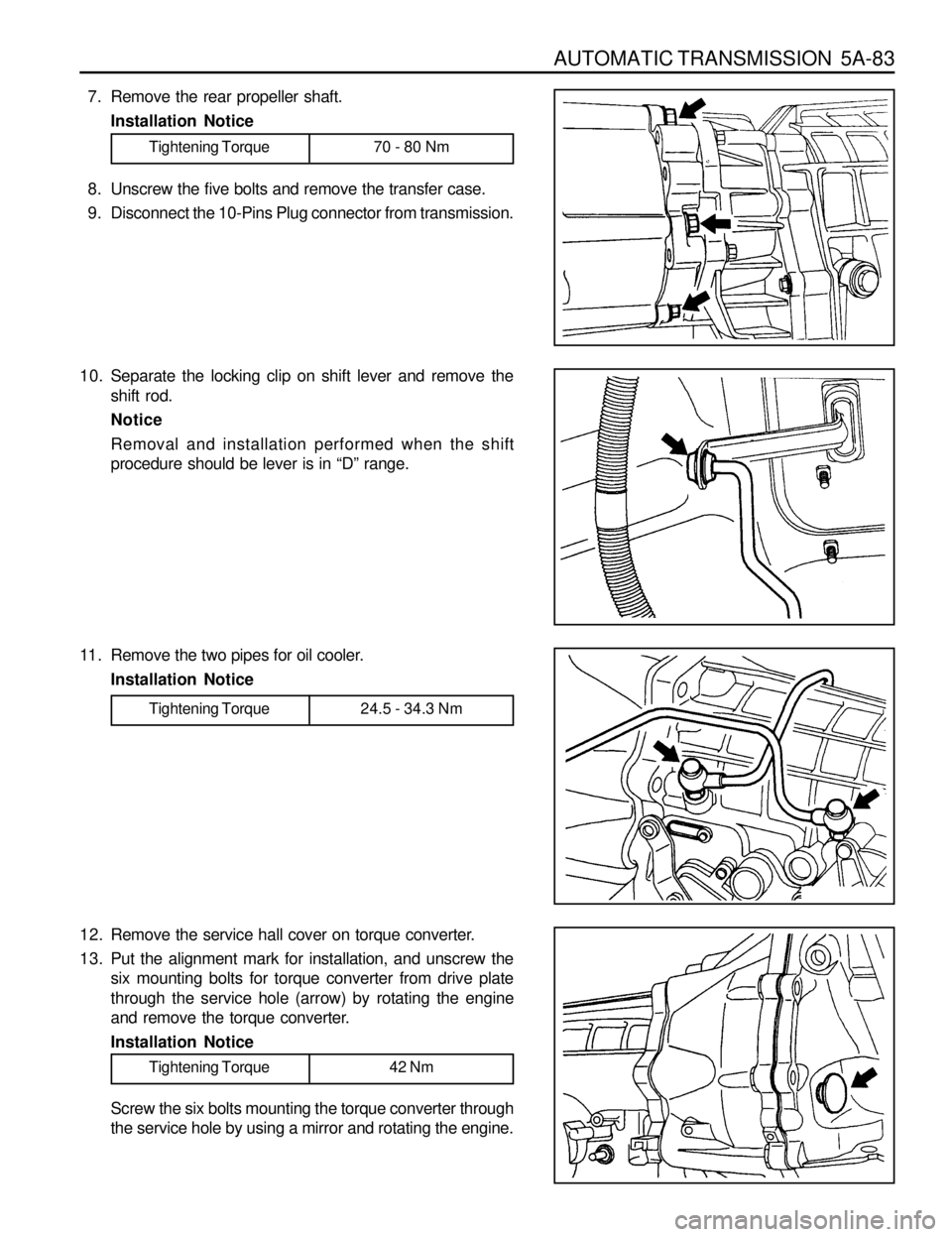engine oil SSANGYONG MUSSO 1998 Workshop Repair Manual
[x] Cancel search | Manufacturer: SSANGYONG, Model Year: 1998, Model line: MUSSO, Model: SSANGYONG MUSSO 1998Pages: 1463, PDF Size: 19.88 MB
Page 1029 of 1463

5A-52 AUTOMATIC TRANSMISSION
POWER FLOW - DRIVE 2 AND MANUAL 2
In Drive 2 and Manual 2, transmission drive is via the input shaft and forward clutch cylinder. The elements of the
transmission function as follows :
lThe C2 clutch is applied to drive the forward sun gear.
lThe forward sun gear drives the short pinion anti-clockwise.
lThe short pinion drives the long pinion clockwise.
lThe B1 band is applied holding the reverse sun gear stationary therefore the long pinion ‘walks’ around the
reverse sun gear taking the internal ring gear and output shaft with it in a clockwise or forward direction.
lThe C4 clutch is applied to bypass the 3-4 OWC and provide engine braking on overrun.
Control
To maintain this arrangement in the steady state solenoids and valves are activated as follows: Solenoid S1 is
switched Off. S2 is switched On.
lSolonoid S1 is switched Off. S2 is switched On.
lDrive (line pressure) oil from the manual valve engages the C2 clutch.
lWhen S1 switches off , S1 oil pressure, which is derived from line 500 pressure, moves the 3-4 shift valve to
the left. At the same time S1 oil is directed to the 1-2 shift valve which moves the valve to the second gear
position.
l2nd oil (line pressure) from the 1-2 shift valve is directed to the band apply regulator valve, and to the 2-3 shift
valve.
lThe band apply regulator valve supplies 2nd oil (regulated to line pressure multiplied by the valve ratio) to the
band apply feed (BAF) circuit.
lBand apply feed oil is directed to:
- The outer apply area of the front servo
- The 1-2 shift valve to provide an exhaust port when the transmission is shifted to first gear
- The 3-4 shift valve for use when the transmission is shifted into fourth gear
lDrive (line pressure) is routed through the 3-4 shift valve to apply the C4 clutch.
Refer to figure 5.5 and table 5.6.
Table 5.6 - Engaged Elements - Drive 2 and Manual 2
Gear State
Drive 2 and Manual 2C1
-C2
XC3
-C4
XB1
XB2
-1-2
OWC
-3-4
OWC
XLU
CLUTCH
- ELEMENTS ENGAGED
Page 1031 of 1463

5A-54 AUTOMATIC TRANSMISSION
POWER FLOW - DRIVE 3 AND MANUAL 3
In Drive 3 and Manual 3, transmission drive is via the input shaft to the forward clutch cylinder. The elements of the
transmission function as follows :
lThe C2 clutch is engaged to drive the forward sun gear.
lThe C1 clutch is engaged to drive the planet carrier.
lThe forward sun gear and the planet carrier are driven clockwise at the same speed therefore there is no
relative motion between the sun gear and the pinions.
lThe ring gear and output shaft are driven in a clockwise or forward direction at input shaft speed.
lThe C4 clutch is applied to bypass the 3-4 OWC and provide engine braking on overrun.
Control
To maintain this arrangement in the steady state solenoids and valves are activated as follows:
lSolenoid S1 is switched Off. S2 is switched Off.
lWith S1 and S2 switched Off, the 2-3 and 3-4 shift valves are held in the third gear position by line 500
pressure.
lThe 1-2 shift valve is held in the third gear position by S1-S2 oil pressure.
l2nd oil (line pressure) from the 1-2 shift valve is directed to the band apply regulator valve. and to the 2-3 shift
valve.
lThe band apply regulator valve supplies 2nd oil (regulated to line pressure multiplied by the valve ratio) to the
band apply feed (BAF) circuit.
lBand apply feed oil is directed to:
- The outer apply area of the front servo
- The 1-2 shift valve to provide an exhaust port when the transmission is shifted to first gear
- The 3-4 shift valve for use when the transmission is shifted into fourth gear
l2nd oil at the 2-3 shift valve is directed to the 3rd oil circuit.
l3rd oil from the 2-3 shift valve is directed to the clutch apply regulator valve, and to the 4-3 Sequence Valve.
lThe clutch apply regulator valve supplies oil (regulated to line 500 pressure multiplied by the valve ratio) to the
clutch apply feed (CAF) circuit.
l The CAF oil is directed to:
- The C1 clutch
- The C1 bias valve
- The 4-3 sequence valve
lAt the 4-3 sequence valve the CAF oil becomes band 1 release feed (B1R-F) oil, and is directed through the
3-4 shift valve to the spring end of the 4-3 sequence valve, and to the release side of the front servo piston to
hold band 1 off.
lDrive (line pressure) is routed through the 3-4 shift valve to apply the C4 clutch.
Refer to figure 5.6 and table 5.7.
Table 5.7 - Engaged Elements - Drive 3 and Manual 3
Gear State
Drive 3 and Manual 3C1
XC2
XC3
-C4
XB1
-B2
-1-2
OWC
-3-4
OWC
XLU
CLUTCH
- ELEMENTS ENGAGED
Page 1037 of 1463

5A-60 AUTOMATIC TRANSMISSION
DIAGNOSIS
DIAGNOSTIC SYSTEM
Recommended Test Equipment and Procedure
The test equipment is designed to be used with the control modules in all vehicles. The components used in the
transmission application are:
lMulti Function Tester, and
lAppropriate vehicle for testing.
Multi Function Tester (MFT)
The MFT is programmed with the special vehicle diagnostic software that allows selection of the unit under test.
The program allows the proper communication to the Transmission Control Unit (TCU).
It then requests information from the user via a menu system to select the required set up.
Examples are viewing codes, clearing error codes, and real-time operation. Set up and operation instructions are
detailed in the user manual.
This equipment can be used by trained personnel such as technicians and mechanics to diagnose electronic and
wiring problems relating to the vehicle transmission. Information that is available includes engine and road (shaft)
speed, transmission oil temperature, throttle position, solenoid/gear status and gear lever position. Current and
stored faults detected by the electronics are also available.
TCU Pin Description
The TCU pin descriptions are listed in table 6.1.1.
The wiring loom pins are shown in figure 6.1.1
Pin
No.
1
2
3
4
5
6
7
8Identification
Common Ground
Do not use
Mode Indicator Lamp -
‘Winter’
Gear Position ‘Park’
Lamp
Gear Position ‘Reverse’
Lamp
Gear Position ‘Neutral’
Lamp
Do not use
Engine Speed Input
Sensor (-Ve)Type
GND
-
OP
OP
OP
OP
-
IPDescription
Main power ground (or the module. Connects
directly to the battery negative terminal.
Indicates ‘WINTER’ mode shift schedule is se-
lected.
Drives the jewel in the instrument cluster to in-
dicate ‘PARK’ gear lever position.
Drives the jewel in the instrument cluster to in-
dicate ‘REVERSE’ gear lever position.
Drives the jewel in the instrument cluster to in-
dicate ‘NEUTRAL’ gear lever position.
Flywheel/Ring gear pulses to indicate engine
speed. 4WD
(Diesel)
O
O
l
l l l
l
4WD
(Gas)
O
O
O
l
l l l
l
l
Table 6.1.1 - TCU Pin Description
Page 1046 of 1463

AUTOMATIC TRANSMISSION 5A-69
MECHANICAL TESTS
In Vehicle Transmission Checks
Carry out the following tests before removing the transmission.
lSee Checking Transmission Fluid Level, Section 7.2.1.
lCheck that the transmission oil is not burnt (colour and smell are correct).
lEnsure that the transmission is not in limp home mode (LHM).
lCheck that the battery terminals and the earth connections are not corroded or loose.
lCheck the engine stall speed is within the handbook value.
lCheck that the cooler flow is not restricted.
lCheck that all electrical plug connections are tight.
lCarry out a road test to confirm the symptoms, if necessary.
lInspect the oil, ensure that there are no metal or other contaminants in the oil pan.
Diagnosing Oil Leaks
Determine the source of oil leaks by firstly cleaning down the affected area, then driving the vehicle.
Inspect the seals to confirm the source of the leak.
lTo determine the source of a rear servo oil leak, raise the vehicle on a hoist, then carry out a reverse stall.
lTo determine the source of a front servo leak, raise the vehicle on a hoist, then run the vehicle in second gear.
Troubleshooting Charts
The troubleshooting charts are set out as follows:
lTable 6.2.1 Drive Faults,
lTable 6.2.2 Faulty Shift Patterns.
lTable 6.2.3 Shift Quality Faults.
lTable 6.2.4 After Teardown Faults.
Table 6.2.1 - Drive Faults
Action
Check the fluid level. Top up as necessary.
Inspect and clean C1/C2 feed.
Reinstall/renew the ‘z’ link.
Remove, clean and re-install the PRV.
Inspect and replace as necessary.
Inspect and replace as necessary.
Inspect and replace as necessary.
Check servo adjustment or replace rear band
as necessary.
Check for failure in C3, C3 hub or C1/C2 cylin-
der. Repair as necessary.
Inspect and clean PRV.
Inspect and replace pump gears as necessary.
Inspect and repair as necessary. Possible Cause
Insufficient auto transmission fluid.
Blocked feed in C1/C2 cylinder.
‘Z’ link displaced.
Primal regulator valve (PRV) jammed open.
Overdrive shaft or input shaft seal rings
failed.
3-4 or 1-2 one way clutch (OWC) installed
backwards or failed.
C2 piston broken or cracked.
Rear band or servo faulty.
Failure in C3, C3 hub or C1/C2 cylinder.
Jammed primary regulator valve (PRV).
Damaged/broken pump gears.
Dislodged output shaft snap ring.Symptom
No Drive in D
No Drive in
Reverse
No engine braking
in Manual 1
Engine braking in
Manual 1 is OK
No drive in Drive
and Reverse
Page 1053 of 1463

5A-76 AUTOMATIC TRANSMISSION
Action
lCheck cable for open / short.
lCheck connection of other connectors.
lCheck voltage between terminal 27 and 29 of TCU,
- Standard value : 0.2 - 4.7V
lCheck TPS.
lCheck cable for open / short.
lCheck connection of other connectors.
lCheck engine speed sensor.
lCheck resistance between terminal 8 and 24 of TCU (when the
connector is disconnected).
- Standard value : 1 .9 - 0.2 k
W
lCheck cable for open / short.
lCheck connection of other connectors.
lCheck vehicle speed sensor.
lCheck cable for open / short.
lCheck connection of other connectors.
lCheck engine speed sensor.
lCheck inhibitor switch resistance between terminal 34 and 37 of
TCU(when the connector is disconnected).
- Standard value : 1st gear - 4 - 4.4 k
W
2nd gear - 4,8 - 2.2 kW
3rd gear - 3 - 3.4 kW
D gear - 4.5 - 4.g kW
N gear - 6.8 - 7.2 kW
R gear - 10.8 -11.2 kW
P gear - 18.6 - 19 kW
lCheck voltage between terminal 31 and 37 of TCU.
- Standard value : 0-5V(P,R,N,D,L)
lCheck cable for open / short.
lCheck connection of other connectors.
lCheck mode switch.
lCheck condition between terminal 1 and 13 of TCU.
Winter mode :12V, Normal mode : Open status, Power mode : 0V
lCheck cable for open / short.
lCheck connection of other connectors.
lCheck voltage between terminal 32 and 38 of TCU.
- Standard value : 0-5V
lCheck oil temperature sensor.
lCheck cable for open / short.
lCheck connection of other connectors.
lCheck battery condition.
lCheck alternator. Possible Cause
Throttle position sensor
Engine RPM
Vehicle speed
Shift lever
W, E, P mode switch
T/M oil temperature
Battery voltage Symptom
P1702
P1703
P1704
P4705
P1706
P1707
P1708
Self-diagnosis List
Page 1056 of 1463

AUTOMATIC TRANSMISSION 5A-79
ADJUSTMENTS
HYDRAULIC SYSTEM
The procedures detailed below should be followed in the event that the self test procedure detailed in section 6, or a
defect symptom, indicates that there is a fault in the hydraulic system.
When making adjustments to the transmission, select the appropriate procedures from the following preliminary
checks.
lConduct a transmission fluid test procedure, refer to section 7.2.
lCheck the manual linkage adjustment (refer to the vehicle workshop manual).
lCheck engine idle speed (refer to Section 7.3).
lConduct a stall test (it is outside the scope of this publication to detail this procedure)
lconduct a road test (it is outside the scope of this publication to detail this procedure).
TRANSMISSION FLUID TEST PROCEDURE
Checking Transmission Fluid Level
This procedure is to be used when checking a concern with the fluid level in a vehicle. A low fluid level will result in
gearshift loss or delay if driven when the vehicle is cold.
The vehicle is first checked for transmission diagnostic messages (refer to section 6). If the vehicle has a speedo fault
it is possible for the oil level to be low.
The vehicle is to be test driven to determine if there is an abnormal delay when selecting drive or reverse, or loss of
drive. One symptom of low oil level is a momentary loss of drive when driving the vehicle around a comer. Also when
the transmission fluid level is low, a loss of drive may occur when the transmission oil temperature is low.
If there is no loss of drive when the vehicle is driven warm and a speedo fault is registered, then fluid should be added
to the transmission.
Checking, Adding Fluid and Filling
When adding or changing transmission oil use only Castrol TQ 95 automatic transmission fluid (ATF) or other approved
fluids. The use of incorrect oil will cause the performance and durability of the transmission to be severely degraded.
Do not underfill the transmission. Incorrect tilling may cause damage to the transmission. The fluid level setting
procedure is detailed below.
Notice
When a transmission is at operating temperature hot transmission fluid may come out of the case if the fill plug is
removed. 9 the transmission is at operating temperature allow two hours for cooling prior to removing the plug.
1. If the vehicle is at operating temperature allow the vehicle to cool down for two, but no greater than four hours
before adding transmission fluid (this will allow the transmission to be within the correct temperature
range).
While hot the ATF level is higher and removing the plug may result in oil being expelled from the filler hole. This
will result in the level being low.
2. The transmission selector is to be in Park.
Switch the engine off.
3. Raise the vehicle on a hoist (or leave over a service pit).
4. Clean all dirt from around the service fill plug prior to removing the plug. Remove the oil service fill plug.
Clean the fill plug and check that there is no damage to the ‘O’ ring.
Install the filler pump into the filler hole.
5. Lower the vehicle with the filler pump still connected and partially fill the transmission.
Start the vehicle in Park with the Parking brake and foot brake applied with the engine idling, cycle the transmission
gear selector through all positions, adding ATF until gear application is felt.
Page 1057 of 1463

5A-80 AUTOMATIC TRANSMISSION
6. Switch off the engine and raise the vehicle on the hoist, if applicable, ensuring that the vehicle is level.
7. Three minutes after the engine has stopped, but no longer than one hour, remove the filler pump, The correct
level is reached when ATF is aligned with the bottom of the filler hole. If the correct level is not reached, then add
a small quantity of ATF to the correct level.
8. Replace the transmission filler plug and clean all remnants of ATF on the transmission and vehicle.
9. Tighten the transmission filler plug to specification.
Checking, Adding Fluid and Filling - Drained or Dry Transmission
To set the correct fluid level proceed as follows.
1. Set the transmission selector to Park and switch the engine off.
2. Raise the vehicle on a hoist (or leave over a service pit).
3. Clean all dirt from around the service fill plug prior to removing the plug, Remove the oil service fill plug. Clean the
fill plug and check that there is no damage to the ‘O’ ring. Install the filler pump into the filler hole.
4. Lower the vehicle with the filler pump still connected and partially fill the transmission. This typically requires
approximately :
a. If the transmission torque converter is empty:
9.0 litres - 4WD
9.0 litres - RWD
b. If the transmission torque converter is full:
4.5 litres - 4WD
4.5 litres - RWD
5. Start the vehicle in Park with the Parking brake and foot brake applied with the engine idling, cycle the transmission
gear selector through all positions, adding ATF until gear application is felt.
6. Then add an additional 0.5 litres of ATF.
7. Switch off the engine and raise the vehicle on the hoist. Remove the filler pump and replace the filler plug. The
plug shall be tightened to specification.
8. The vehicle is then to be driven between 3.5 and 4.5 kilometers at light throttle so that the engine does not
exceed 2500 rpm. This should result in the transmission temperature being in the range 50 to 60°C.
9. With the engine idling, cycle the transmission selector through all gear positions with the brake applied.
10. Stop the engine. Raise the vehicle on the hoist, if applicable ensuring the vehicle is level.
11. Three minutes after the engine has stopped, but no longer than one hour, remove the filler plug. The correct
level is reached when ATF is aligned with the bottom of the filler hole. If the correct level is not reached, then add
a small quantity of ATP to the correct level.
12. Replace the transmission filler plug and clean all remnants of ATF on the transmission and vehicle. Tighten the
transmission Filler plug to specification.
ELECTRONIC ADJUSTMENTS
Idle Speed Adjustment
Carry out the adjustments to the idle speed as detailed in the workshop manual.
Throttle Position Calibration
Should the throttle position data stored in the TCU be lost or be out of specification, as indicated by a diagnostic
trouble message, it may be re-established by the following procedure.
lCheck that the hot engine idle speed is within specification.
lAllow the engine to idle in ‘Drive’ for 60 seconds with the air conditioner (if fitted) turned off. The closed throttle
reference point in the TCU has now been set.
Switch the engine off but leave the ignition on. Hold the accelerator pedal on the floor for 60 seconds. The wide open
throttle reference point in the TCU has now been set.
Page 1060 of 1463

AUTOMATIC TRANSMISSION 5A-83
Tightening Torque 70 - 80 Nm
11. Remove the two pipes for oil cooler.
Installation Notice
Tightening Torque24.5 - 34.3 Nm
12. Remove the service hall cover on torque converter.
13. Put the alignment mark for installation, and unscrew the
six mounting bolts for torque converter from drive plate
through the service hole (arrow) by rotating the engine
and remove the torque converter.
Installation Notice
Tightening Torque 42 Nm
7. Remove the rear propeller shaft.
Installation Notice
8. Unscrew the five bolts and remove the transfer case.
9. Disconnect the 10-Pins Plug connector from transmission.
10. Separate the locking clip on shift lever and remove the
shift rod.
Notice
Removal and installation performed when the shift
procedure should be lever is in “D” range.
Screw the six bolts mounting the torque converter through
the service hole by using a mirror and rotating the engine.
Page 1112 of 1463

MANUAL TRANSMISSION 5B-5
Check
Clutch not releasing.
Improper or low transmission oil.
Shift or shift rail binding.
Binding of sliding synchronizers or gears.
If reverse only, faulty backup switch.
Worn or damaged flywheel pilot bushing.Check
Control lever assembly broken or damaged.
Damaged offset lever, shift fork, selector place or
selector arm.
DIAGNOSIS
WILL NOT SHIFT(CONTROL LEVER MOVES)
Action
Replace control lever and housing assembly.
Remove extension, adapter or case cover.
Check or replace damaged parts.
HARD SHIFT OR CONTROL LEVER WILL NOT MOVE INTO GEAR
Action
Adjust or replace clutch.
Add or replace with specified oil.
Remove extension, adapter or case cover.
Check or replace damaged parts.
Remove extension, adapter or case cover.
Check synchronizers and gears and replace
damaged parts.
Check or replace backup switch.
Replace pilot bushing.
GEARS CRASH WHEN SHIFTING
Check
Engine idle speed too high.
Damaged or faulty clutch.
Pilot bearing between input shaft and output shaft binding.
Damaged synchronizer.
Bell housing misaligned.
Damaged gear(s).
Worn or damaged flywheel pilot bushing.Action
Adjust idle speed to specified speed.
Adjust or replace clutch.
Replace or check roller bearings.
Check or replace synchronizer parts.
Align bell housing and bore.
Check or replace gear(s).
Replace pilot bushing.
Page 1113 of 1463

5B-6 MANUAL TRANSMISSION
Check
Loosened transmission or flywheel housing bolts,
improper alignment.
Synchronizer damaged or excessively worn.
Blocking ring damaged, worn index slots or friction
surfaces worn or damaged.
Excessive countershaft end play.
Worn or damaged fork due to loosened shaft, rail or
shifting fork.
TRANSMISSION JUMPS OUT
Action
Tighten bolts to specified value. Realign if necessary.
Check or replace synchronizer parts.
Check or replace blocking ring.
Check worn or damaged parts. Adjust shim thickness
using roller bearings if necessary.
Check for wear or damaged. Replace worn or
damaged parts.
Check
Fork or offset lever loose on shaft or rail.
Worn or damaged forks, offset lever, shaft or rail.
Worn or damaged synchronizer.
Worn or damaged gears.
TRANSMISSION LOCKED IN ONE GEAR
Action
Replace extension, adapter or case cover. Check or
replace loose parts on shaft or rail. Replace roll pin(s).
Remove extension, adapter or case cover. Check for
wear or damaged. Replace damaged parts.
Check worn or damaged synchronizer parts and
replace if necessary.
Check worn or damaged gears and replace if neces-
sary.
Check
Improper or low transmission oil.
Loose bolts or other attaching parts.
Improper flywheel housing to engine crankshaft
alignment.
Noisy transmission bearing.
Noisy gears.
TRANSMISSION NOISE
Action
Add or drain and replace with proper oil.
Tighten as specified.
Realign correctly.
Check bearings, bearing rollers and parts for wear or
damage.
Replace if necessary.
Check for worn or damaged gears
(including speedometer gear).
Replace if necessary.